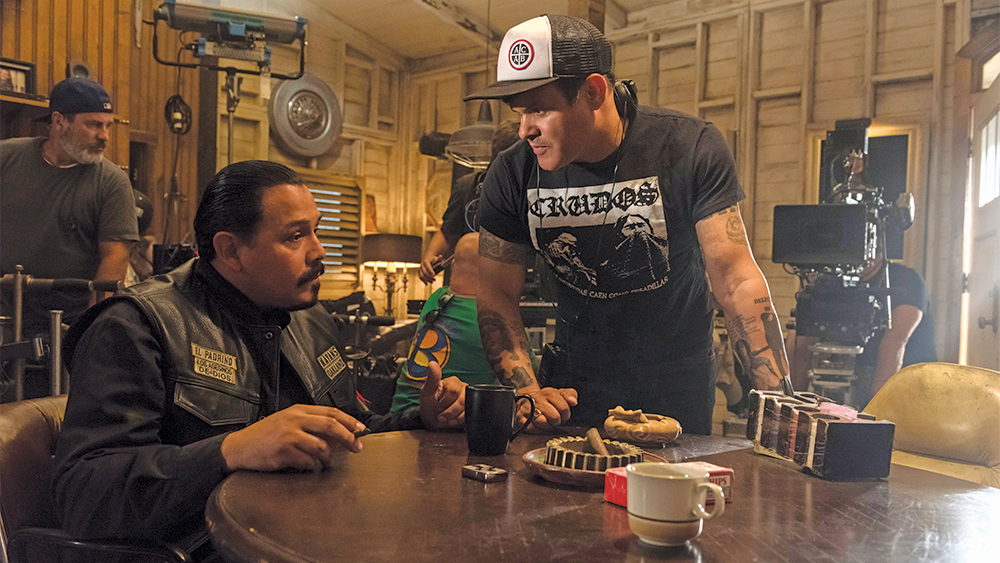How a Former Gang Member Lent Authenticity to ‘Mayans M.C.’
By Elgin James
LOS ANGELES (Variety.com) – A former gang member, Elgin James spent a year in prison in 2011 for extortion, just after his film “Little Birds” premiered at Sundance to rave reviews. Here, he talks to Variety’s Debra Birnbaum about his journey out from behind bars to “Mayans M.C.,” the sequel to Kurt Sutter’s “.” James serves as co-creator and an executive producer of “Mayans,” which debuts on FX on Sept. 4.
I’d been out of prison for a few years, and I said that I would never tell stories about violence and gangs in my past. I just wasn’t interested in it. Even the film that I made called “Little Birds,” which was about me and my best friend joining a street gang, I turned into a story about two 15-year-old girls running away. Then I heard that Kurt Sutter was meeting with writers to talk about an idea he had for a follow-up to “Sons.”
I was more nervous going to meet Kurt then I was going into prison. Prison was something that I understood, a language that I know for better or worse, having grown up surrounded by violence. But this industry, this town is so foreign and actually pretty terrifying to me. After talking to Kurt about being in a gang for the majority of my life, I just realized that I had to write this story. This is stuff that I’m still wrestling with, that is still inside me that I was trying to ignore.
The cliché you always hear in Hollywood is that people are in a gang because they’re looking for a family. I think there’s some truth to that, but there’s more to it. You want to take over the world. That’s what you’re really looking for. It’s really like, f— the status quo. The game is rigged against you, so you’re going to set your own rules.
When I was a kid, I was always told, “You’re a piece of s—. You’re a lowlife.” You start to believe it, and it becomes a self-fulfilling prophecy. People tell you that you’re no good, so you start to act like you’re no good. You band together with other people like you. You lift weights, you start to get tattoos, because you’re scared of everyone on the other side of the street and you want to keep them on the other side of the street. And then when you walk into a room or down the street, people see you and they’re terrified of you. That’s an intoxicating feeling. I was being seen and heard for the first time in my life. In talking about it with Kurt, I could see the whole path from being a scared little kid to being in a gang. And that’s the kind of story that I wanted to tell, to put a human face to it — that we are all the same in that we’re all terrified.
“That’s the kind of story that I wanted to tell, to put a human face to it — that we are all the same in that we’re all terrified.”
We started working on “Mayans” before the election, before things turned into what they’ve turned into in our country. But even then, I was really excited about trying to tell a story about people of color and have a built-in audience of people who probably wouldn’t want to watch a show like that. This isn’t just a TV show for Latinos. It’s for everyone who feels disregarded. Who’s felt invisible. Who’s felt diminished.
The diversity starts in the writers room. What is cool is to look around the room and realize these are all people of my same complexion, to look around the set and see all these people working so hard who are mostly invisible to the world. And now we get to have our say. That was really special, and we knew it.
No one knows the world better than Kurt, and I know the truth of the world that we’re talking about — emotionally, physically. I always say I’m not a Latino filmmaker — I’m a punk rock filmmaker. If you’re mixed, you fit in with everyone but no one fully embraces you back. So I’m used to always being on the outside. What I tried to do, what I learned from Robert Redford, Michelle Satter at the Sundance Labs and the people who found me and created me, who turned me from a criminal into an artist, is just to believe and be as honest as possible. And bleed it out on the paper so then everyone else — the cast, the crew — can lift it up to something. You hope that people see themselves in it.
When I made a little art-house film, which meant so much to me, it’s like this cry into the darkness and usually no one ever yells back. You’re just alone. For someone to yell back, there’s nothing that comes close to that feeling. So to do something on such a big level as this, it’s terrifying. I want people to see this and be entertained, and [I want to] think, “Great, we didn’t f— up the ‘Sons’ of it all.” But at the same time, I hope people see themselves in it, no matter what their circumstances are.

